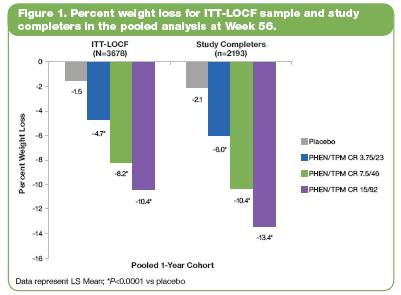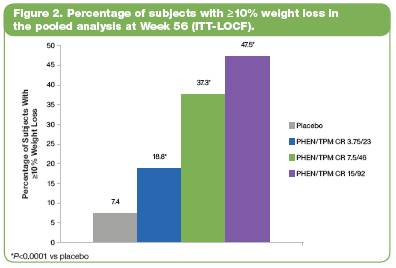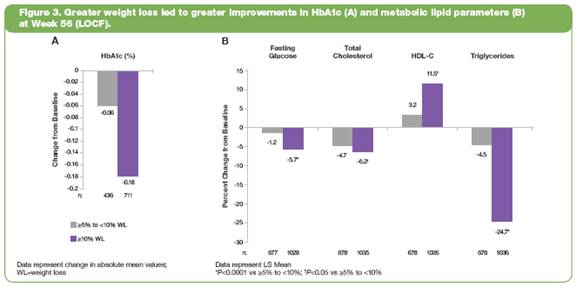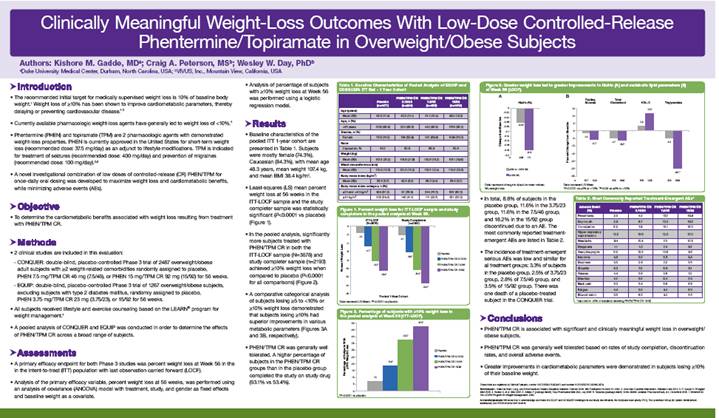Below is a reproduction of the contents of the poster entitled “Clinically Meaningful Weight-Loss Outcomes With Low-Dose Controlled-Release Phentermine/Topiramate in Overweight/Obese Subjects”:
Authors: Kishore M. Gadde, MD(a); Craig A. Peterson, MS(b); Wesley W. Day, PhD(b)
(a)Duke University Medical Center, Durham, North Carolina, USA; (b)VIVUS, Inc., Mountain View, California, USA
· Introduction
· The recommended initial target for medically supervised weight loss is 10% of baseline body weight.(1) Weight loss of >10% has been shown to improve cardiometabolic parameters, thereby delaying or preventing cardiovascular disease.(1)-(3)
· Currently available pharmacologic weight-loss agents have generally led to weight loss of <10%.(4)
· Phentermine (PHEN) and topiramate (TPM) are 2 pharmacologic agents with demonstrated weight-loss properties. PHEN is currently approved in the United States for short-term weight loss (recommended dose: 37.5 mg/day) as an adjunct to lifestyle modifications. TPM is indicated for treatment of seizures (recommended dose: 400 mg/day) and prevention of migraines (recommended dose: 100 mg/day).(5),(6)
· A novel investigational combination of low doses of controlled-release (CR) PHEN/TPM for once-daily oral dosing was developed to maximize weight loss and cardiometabolic benefits, while minimizing adverse events (AEs).
· Objective
· To determine the cardiometabolic benefits associated with weight loss resulting from treatment with PHEN/TPM CR.
· Methods
· 2 clinical studies are included in this evaluation:
· CONQUER: double-blind, placebo-controlled Phase 3 trial of 2487 overweight/obese adult subjects with >2 weight-related comorbidities randomly assigned to placebo, PHEN 7.5 mg/TPM CR 46 mg (7.5/46), or PHEN 15 mg/TPM CR 92 mg (15/92) for 56 weeks.
· EQUIP: double-blind, placebo-controlled Phase 3 trial of 1267 overweight/obese subjects, excluding subjects with type 2 diabetes mellitus, randomly assigned to placebo, PHEN 3.75 mg/TPM CR 23 mg (3.75/23), or 15/92 for 56 weeks.
· All subjects received lifestyle and exercise counseling based on the LEARN® program for weight management.(7)
· A pooled analysis of CONQUER and EQUIP was conducted in order to determine the effects of PHEN/TPM CR across a broad range of subjects.
· Assessments
· A primary efficacy endpoint for both Phase 3 studies was percent weight loss at Week 56 in the in the intent-to-treat (ITT) population with last observation carried forward (LOCF).
· Analysis of the primary efficacy variable, percent weight loss at 56 weeks, was performed using an analysis of covariance (ANCOVA) model with treatment, study, and gender as fixed effects and baseline weight as a covariate.
· Analysis of percentage of subjects with >10% weight loss at Week 56 was performed using a logistic regression model.
· Results
· Baseline characteristics of the pooled ITT 1-year cohort are presented in Table 1. Subjects were mostly female (74.3%), Caucasian (84.3%), with mean age 48.3 years, mean weight 107.4 kg, and mean BMI 38.4 kg/m2.
Table 1. Baseline Characteristics of Pooled Analysis of EQUIP and CONQUER: ITT Set - 1 Year Cohort
| | | | PHEN/TPM CR | | PHEN/TPM CR | | PHEN/TPM CR | |
| | Placebo | | 3.75/23 | | 7.5/46 | | 15/92 | |
| | (n=1477) | | (n=234) | | (n=488) | | (n=1479) | |
Age (years) | | | | | | | | | |
Mean (SD) | | 48.5 (11.4) | | 43.0 (11.1) | | 51.1 (10.4) | | 48.0 (12.0) | |
Age, n (%) | | | | | | | | | |
<65 years | | 1382 (93.6) | | 230 (98.3) | | 442 (90.6) | | 1376 (93.0) | |
Gender, n (%) | | | | | | | | | |
Female | | 1102 (74.6) | | 194 (82.9) | | 341 (69.9) | | 1094 (74.0) | |
Race | | | | | | | | | |
Caucasian, % | | 84.7 | | 80.8 | | 86.9 | | 83.5 | |
Weight (kg) | | | | | | | | | |
Mean (SD) | | 107.5 (20.2) | | 118.6 (21.9) | | 102.8 (18.2) | | 107.1 (19.6) | |
Waist circumference (cm) | | | | | | | | | |
Mean (SD) | | 115.8 (13.3) | | 121.5 (15.2) | | 112.7 (12.4) | | 115.5 (13.5) | |
Body mass index (kg/m2) | | | | | | | | | |
Mean (SD) | | 38.5 (5.7) | | 42.5 (6.5) | | 36.3 (4.4) | | 38.4 (5.7) | |
Body mass index category n (%) | | | | | | | | | |
>30 and <40 kg/m2 | | 904 (61.2) | | 91 (38.9) | | 344 (70.5) | | 887 (60.0) | |
>40 kg/m2 | | 502 (34.0) | | 143 (61.1) | | 111 (22.7) | | 521 (35.2) | |
· Least-squares (LS) mean percent weight loss at 56 weeks in the ITT-LOCF sample and the study completer sample was statistically significant (P<0.0001 vs placebo) (Figure 1).

· In the pooled analysis, significantly more subjects treated with PHEN/TPM CR in both the ITT-LOCF sample (N=3678) and study completer sample (n=2193) achieved >10% weight loss when compared to placebo (P<0.0001 for all comparisons) (Figure 2).

· A comparative categorical analysis of subjects losing >5 to <10% or >10% weight loss demonstrated that subjects losing >10% had superior improvements in various metabolic parameters (Figures 3A and 3B, respectively).

· PHEN/TPM CR was generally well tolerated. A higher percentage of subjects in the PHEN/TPM CR groups than in the placebo group completed the study on study drug (63.1% vs 53.4%).
· In total, 8.8% of subjects in the placebo group, 11.6% in the 3.75/23 group, 11.6% in the 7.5/46 group, and 18.2% in the 15/92 group discontinued due to an AE. The most commonly reported treatment-emergent AEs are listed in Table 2.
Table 2. Most Commonly Reported Treatment-Emergent AEs*
Adverse Event | | | | PHEN/TPM CR | | PHEN/TPM CR | | PHEN/TPM CR | |
(%) | | Placebo | | 3.75/23 | | 7.5/46 | | 15/92 | |
Paresthesia | | 2.0 | | 4.2 | | 13.7 | | 19.9 | |
Dry mouth | | 2.9 | | 6.7 | | 13.5 | | 19.5 | |
Constipation | | 6.2 | | 7.9 | | 15.1 | | 16.3 | |
Upper respiratory tract infection | | 12.2 | | 15.8 | | 12.2 | | 13.0 | |
Headache | | 9.4 | | 10.4 | | 7.0 | | 10.8 | |
Dysgeusia | | 1.1 | | 1.3 | | 7.4 | | 9.7 | |
Nasopharyngitis | | 8.2 | | 12.5 | | 10.6 | | 9.6 | |
Insomnia | | 4.8 | | 5.0 | | 5.8 | | 9.4 | |
Dizziness | �� | 3.5 | | 2.9 | | 7.2 | | 8.5 | |
Sinusitis | | 6.3 | | 7.5 | | 6.8 | | 8.1 | |
Nausea | | 4.4 | | 5.8 | | 3.6 | | 7.0 | |
Diarrhea | | 4.7 | | 5.0 | | 6.4 | | 5.4 | |
Back pain | | 5.0 | | 5.4 | | 5.6 | | 6.6 | |
Fatigue | | 4.4 | | 5.0 | | 4.4 | | 6.0 | |
Blurred vision | | 3.5 | | 6.3 | | 4.0 | | 5.5 | |
*reported in >5% of subjects receiving PHEN/TPM CR 15/92
· The incidence of treatment-emergent serious AEs was low and similar for all treatment groups: 3.3% of subjects in the placebo group, 2.5% of 3.75/23 group, 2.8% of 7.5/46 group, and 3.5% of 15/92 group. There was one death of a placebo-treated subject in the CONQUER trial.
· Conclusions
· PHEN/TPM CR is associated with significant and clinically meaningful weight loss in overweight/obese subjects.
· PHEN/TPM CR was generally well tolerated based on rates of study completion, discontinuation rates, and overall adverse events.
· Greater improvements in cardiometabolic parameters were demonstrated in subjects losing >10% of their baseline weight.
These trials are registered at ClinicalTrials.gov, number NCT00554216 (EQUIP) and number NCT00553787 (CONQUER).
References: (1) National Heart, Lung, and Blood Institute Obesity Education Initiative. October 2000. NIH Publication Number 00-4084. (2) American Diabetes Association. Diabetes Care 2010. (3) Pi-Sunyer X. Postgrad Med 2009. (4) Rucker D, et al. BMJ 2007. (5) Adipex-P [package insert]. Teva Pharmaceuticals USA; July 2005. (6) Topamax [package insert]. Ortho-McNeil-Janssen Pharmaceuticals, Inc.; December 2009. (7) Brownell KD. The LEARN Program for Weight Management. 2004.
Acknowledgements: We would like to acknowledge and thank the EQUIP and CONQUER investigators and study coordinators, the Medpace team (study CRO), The Lockwood Group (for poster development assistance), and VIVUS internal contributors.



